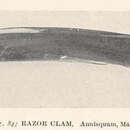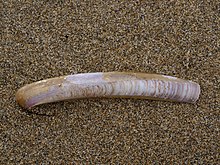en
names in breadcrumbs


Ar c'hontelleg kamm (Ensis ensis) a zo ur blotvil daougleurek.
Ar c'hontelleg kamm a c'hell bezañ renket er c'herentiad Solenidae ivez.
a vo kavet e Wikimedia Commons.
Ar c'hontelleg kamm (Ensis ensis) a zo ur blotvil daougleurek.
Ensis ensis és una espècie de navalla (mol·lusc). És comestible però no gaire freqüent en els mercats de Catalunya.
Les seves closques poden arribar a fer 15 cm i són una mica corbes.[1]
Viuen soterrats a poca fondària quedant a la vista només el forat per on treuen el sifó per a nodrir-se del plàncton que filtren.
Com els altres solènids els ganivets, mànecs de ganivet, canyuts o canyetes s'acostumen a fer a la planxa amb oli i suc de llimona.
E. ensis es troba a les costes del nord-oest d'Europa, des del mar Bàltic[1] i Noruega fins a les costes atlàntiques d'Espanya i Portugal. És força comú a les costes bretones.[2]
Ensis ensis és una espècie de navalla (mol·lusc). És comestible però no gaire freqüent en els mercats de Catalunya.
Les seves closques poden arribar a fer 15 cm i són una mica corbes.
Viuen soterrats a poca fondària quedant a la vista només el forat per on treuen el sifó per a nodrir-se del plàncton que filtren.
Die Schwertförmige Scheidenmuschel (Ensis ensis), auch Schwertförmige Messerscheide, Gebogene Schwertmuschel (oder unspezifisch auch nur Schwertmuschel) genannt, ist eine Muschelart aus der Familie der Pharidae, die im Atlantik und seinen Nebenmeeren weit verbreitet ist.
Die Schwertförmige Scheidenmuschel besitzt ein sehr langes, schmales, gleichklappiges Gehäuse, es wird bis 13 cm lang und etwa 1,3 cm hoch. Das Längen-/Breitenverhältnis ist etwa 8 bis 9. Das Gehäuse ist immer auch mehr oder weniger deutlich gebogen. Der Dorsal- und Ventralrand verlaufen fast parallel. Das Vorderende ist gerundet, das Hinterende schräg abgestutzt. Die Wirbel liegen nahe dem Vorderrand. Vorder- und Hinterende klaffen ständig, bedingt durch den Austritt des muskulösen Fußes am Vorderende und die kurzen Siphonen am Hinterende.
Das Ligament liegt außen als ein langes, schmales braunes Band hinter den Wirbeln. Das Schloss besitzt in der rechten Klappe einen kurzen, hakenförmigen Kardinalzahn und einen horizontalen, länglichen Kardinalzahn; in der linken Klappe sind zwei Kardinalzähne und zwei hintere, waagrecht verlaufende, längliche Kardinalzähne, die übereinander sitzen, vorhanden.[Anmerkung 1] Der vordere Schließmuskel ist groß und lang ausgezogen, der hintere Schließmuskel klein und nahe dem Mantelrand. Dieser bildet am Hinterende einen tiefen und breiten Sinus.
Die Schale ist dünnwandig und spröde. Die Außenseite des Gehäuses weist nur randparallele Anwachslinien auf. Farblich ist das Gehäuse diagonal vom Wirbel (vorne) zum Unterrand des Hinterendes unterteilt. Das obere Diagonalfeld ist weißlich, das untere Diagonalfeld bräunlich gefärbt. Das Periostracum ist grünlichgelb bis dunkelgrün gefärbt und glänzt. Der Innenrand des Gehäuses ist glatt. Die Innenseite ist weißlich, oft blau oder violett getönt.
Alle Arten der Gattung Ensis (z. B. Amerikanische Scheidenmuschel) sind sich sehr ähnlich und unterscheiden sich nur wenig durch Färbung, Größe und Maßverhältnisse des Gehäuses.
Die Art kommt in den Küstengewässern des Nordatlantik von Norwegen bis nach Marokko vor. Die Art ist auch in der Nordsee und der westlichen Ostsee weit verbreitet, ebenso im Mittelmeer.
Die Tiere leben senkrecht eingegraben im lockeren, sandig-schluffigen Sediment mit dem Vorderende nach unten. Das Tier verankert sich im Sediment mit seinem muskulösen Fuß und kann sich bei Störung rasch zurückziehen. Die Art lebt in Wassertiefen von der Gezeitenzone bis in etwa 80 Meter.
Die Tiere sind getrenntgeschlechtlich. Die Eier werden ins freie Wasser abgegeben, und dort befruchtet. Die Entwicklung erfolgt über eine Veliger-Larve, die ungefähr einen Monat im Plankton lebt, bevor sie metamorphosiert und zum Bodenleben übergeht. Sie können bis zu 10 Jahre alt werden und sind nach 3 Jahren geschlechtsreif.
Die Art wurde schon von Carl von Linné erstmals als Solen ensis beschrieben.[1] Die Art wird heute allgemein anerkannt zur Gattung Ensis Schumacher, 1817 gestellt.[2]
Die Schwertförmige Scheidenmuschel (Ensis ensis), auch Schwertförmige Messerscheide, Gebogene Schwertmuschel (oder unspezifisch auch nur Schwertmuschel) genannt, ist eine Muschelart aus der Familie der Pharidae, die im Atlantik und seinen Nebenmeeren weit verbreitet ist.
Ensis ensis, or the sword razor, is a razor clam, a marine bivalve mollusc in the family Pharidae. It lives buried in the sand and is found off the coasts of northwest Europe.

The two valves that make up the shell of Ensis ensis are parallel-sided, narrow and curved. The adult shell can be up to ten centimetres in length. The valves are thin and rather brittle. The edges are parallel, tapering slightly towards the posterior and are off white with transverse bands of brown. The shell is sculpted with fine co-marginal lines and the annual growth lines can be seen. The inner side of the shell is white with a purplish sheen. The periostracum is olive green and the foot is reddish.[2][3] Two identifying features are that the posterior adductor muscle is positioned some one and a half times its own length from the pallial sinus, and that the muscle that retracts the foot is posterior to the insertion point of the ligature. Ensis siliqua and Ensis arcuatus are two other rather similar species that can be found living in the same localities, but the shells of both of them are less curved than this species.[4]
E. ensis occurs off the coasts of northwest Europe, from the Baltic Sea[4] and Norway to the Atlantic coast of Spain and Portugal. It is common around the coasts of Britain.[5]
Ensis ensis burrows into clean or silty sand on the seabed in the neritic zone and the low intertidal zone. When covered with water this bivalve remains close to the surface but when disturbed or when the substrate is exposed it descends to half a metre below the surface. It can tunnel with great rapidity.[6] It has two short siphons that normally extend up to the surface of the sand. It draws in water through one siphon and expels it through the other. By this means it both respires and extracts food particles from the water at the same time.[2] At low tide, a keyhole-shaped depression in the sand is often the only visible sign that the bivalve is present.[6]
Ensis ensis becomes mature at about three years old and may live for ten. Reproduction takes place in the spring and the larvae are pelagic and form part of the zooplankton. After about a month they settle out and burrow into the substrate.[6]
Ensis ensis is often found living in association with other burrowing animals including the sea potato, Echinocardium cordatum, and the bivalve molluscs Tellina fabula and Chamelea gallina.[7]
Ensis ensis, or the sword razor, is a razor clam, a marine bivalve mollusc in the family Pharidae. It lives buried in the sand and is found off the coasts of northwest Europe.
Datil okerra (Ensis ensis) molusku kuskubiko bat da, Pharidae familiakoa. Ipar-mendebaldeko Europan jatorria duen[1] datil hau jateko ona da.
Datil okerra (Ensis ensis) molusku kuskubiko bat da, Pharidae familiakoa. Ipar-mendebaldeko Europan jatorria duen datil hau jateko ona da.
Le couteau-sabre, Ensis ensis, est une espèce de mollusques bivalves appartenant à la famille des Pharidae.
Il s'agit d'un animal aquatique, fouisseur ou foreur. Il se nourrit par filtration d'eau. Il se rencontre fréquemment sur les plages et peut être consommé en tant que fruit de mer.
A navalla,[2] Ensis ensis, é unha especie de molusco bivalvo da orde dos veneroides e familia dos fáridos.
A especie foi definida en 1758 por Linnaeus na 10ª edición do seu Systema Naturae co nome de Solen ensis.[3] Posteriormente reclasificouse no xénero Ensis.
É comestíbel e moi apreciada gastronomicamente.
Ten unha cuncha alongada, algo curvada (máis do que na especie Ensis arcuata) coas valvas simétricas, de até uns 15 cm de lonxitude.[4]
Vive en praias de areas un pouco lamacentas da zona infralitoral.[4]
É unha especie moi común no océano Atlántico nororiental, desde Noruega até o noroeste de África (Marrocos), pasando polo mar do Norte, o canal da Mancha, golfo de Biscaia, Cantábrico e as costas da atlánticas da península Ibérica (entre elas as galegas), e no Mediterráneo.[1]
Segundo Rolán e Otero-Schmitt, encóntrase en toda a costa galega, especialmente desde a ría de Muros e Noia até a desembocadura do Miño, aínda que é pouco abundante.
Estes autores danlle os nomes populares de carallote, carallete, navalla, longueirón e caramelo.[4]
A navalla, Ensis ensis, é unha especie de molusco bivalvo da orde dos veneroides e familia dos fáridos.
A especie foi definida en 1758 por Linnaeus na 10ª edición do seu Systema Naturae co nome de Solen ensis. Posteriormente reclasificouse no xénero Ensis.
É comestíbel e moi apreciada gastronomicamente.
De kleine zwaardschede (Ensis ensis) is een tweekleppigensoort uit de familie van de Pharidae.[1] De wetenschappelijke naam van de soort is voor het eerst geldig gepubliceerd in 1758 door Linnaeus.
De schelp heeft de vorm van een ouderwets scheermes, vandaar de naam. Hij heeft een korte, trechtervormige sipho.
Dit dier graaft zich meestal diep in het zand in en voedt zich alleen bij vloed. Met de sipho zuigt het dier water, zuurstof en voedseldiertjes op, die in het met trilharen bedekte slijmvlies van de kieuwen terechtkomen en naar de mond worden gebracht. Als het dier zich terugtrekt in het zand, is er regelmatig een straaltje water te zien, dat wordt uitgespuwd. Het dier kan zichzelf met zijn gespierde voeten optillen van de zeebodem. De voortbeweging geschiedt door middel van waterdruk. Eerst vult hij zijn lichaam met water en perst dit dan onder grote druk door zijn sipho.
Deze soort komt algemeen voor in de Europese wateren.
Bronnen, noten en/of referentiesDe kleine zwaardschede (Ensis ensis) is een tweekleppigensoort uit de familie van de Pharidae. De wetenschappelijke naam van de soort is voor het eerst geldig gepubliceerd in 1758 door Linnaeus.
Vanlig knivskjell er en art i gruppen knivskjell. Den er en av flere arter av knivskjell som finnes ved norskekysten. Vanlig knivskjell er ikke vanlig nord for Møre, men finnes nord til Troms. Det blir ca. 20 cm langt. Det lever nedgravd i sanden i relativt grunt vann, hvor det står på høykant og filtrerer næring fra vannet.
Vanlig knivskjell er en art i gruppen knivskjell. Den er en av flere arter av knivskjell som finnes ved norskekysten. Vanlig knivskjell er ikke vanlig nord for Møre, men finnes nord til Troms. Det blir ca. 20 cm langt. Det lever nedgravd i sanden i relativt grunt vann, hvor det står på høykant og filtrerer næring fra vannet.